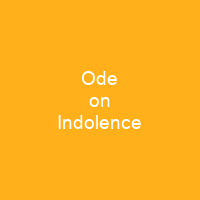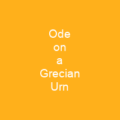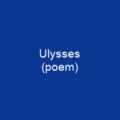The Poem That Speaks of Laziness: An Exploration into Keats’s ‘Ode on Indolence’
Imagine a world where the very essence of laziness is personified and given voice—such is the realm that John Keats explores in his poem, “Ode on Indolence.” This piece delves deep into the heart of indolence, a state synonymous with avoidance or laziness. Is it any wonder then why this poem resonates so deeply with us today?
The Financial Struggles and Artistic Breakthrough
Was Keats’s financial struggle the catalyst for his artistic breakthrough in ‘Ode on Indolence’? Written during a period of personal hardship, this poem marks a significant departure from classical form. It follows three figures—Ambition, Love, and Poesy—each representing different aspects of human experience and desire.
The Three Figures: Ambition, Love, and Poesy
These three figures are not just characters in the poem; they embody Keats’s own inner conflicts. The speaker longs to join them but is unable to do so, leading to a profound internal struggle over his desires. Can you imagine the turmoil within Keats as he grappled with these conflicting emotions?
The Assonance and Poetic Craft
The poem features complex assonance in lines 19 and 31, with repeated vowel sounds such as ye/leave/melt/sense and third/turn’d/time/by/pass’d/passing. These subtle yet powerful linguistic choices add depth to the narrative, making each line resonate more profoundly.
Themes of Humanity and Inner Conflict
The poem explores themes of humanity, human nature, and the inner conflict of pursuing art and ambition while facing the harsh realities of life. The speaker rejects Ambition and Love but struggles with dismissing Poesy due to its role in capturing beauty and acknowledging the impermanence of life.
Reflections on Keats’s Own Experiences
Did Keats’s own experiences as a poet reflect his fears about not being able to complete his epic ‘Hyperion’? The poem is a poignant reflection of his doubts and the tension between artistic ambition and life’s harsh realities. His process was filled with doubt, but his poems end with a hopeful message that he is finally free of desires for Love, Ambition, and Poesy.
Critical Perspectives on ‘Ode on Indolence’
Some critics consider the poem inferior to other works from the same period. Helen Vendler suggests it is a seminal poem establishing Keats’s notion of soul making, a method by which individuals build their souls through suffering and personal experience. This is a fundamental preoccupation of the Romantics.
The Allusions and Classical Influences
Keats’s odes contain a higher degree of allusion than most of his contemporaries’ works. The classical influences he invoked affected other Romantic poets, creating a rich tapestry of literary references that continue to intrigue readers today.
The Emotional State of the Poet
Was Keats’s state of mind during this period truly indolent and supremely careless? Willard Spiegelman suggests that the indolence arises from reluctance to apply himself to poetic creation, while others provide alternative explanations. Literary critics regard ‘Ode on Indolence’ as inferior to Keats’s other 1819 odes, considering it repetitious, declamatory, and structurally infirm.
Biographical Insights
Helen Vendler suggests the poem is primarily biographical rather than poetic. Charles Wentworth Dilke observed that while the poem can be read as a supplemental text, it remains an inferior work compared to ‘Grecian Urn.’ Thomas McFarland wrote that the similarity between the poems is more notable for its dissimilarity: ‘Ode on Indolence’ is a flaccid enterprise hardly bearing mention alongside Keats’s other achievements.
Conclusion
‘Ode on Indolence’ remains a fascinating exploration of human nature and artistic struggle. Despite its perceived shortcomings, it offers valuable insights into the life and mind of one of England’s greatest poets. Through this poem, Keats invites us to reflect on our own inner conflicts and the delicate balance between ambition and laziness in our lives.

You want to know more about Ode on Indolence?
This page is based on the article Ode on Indolence published in Wikipedia (retrieved on December 1, 2024) and was automatically summarized using artificial intelligence.







